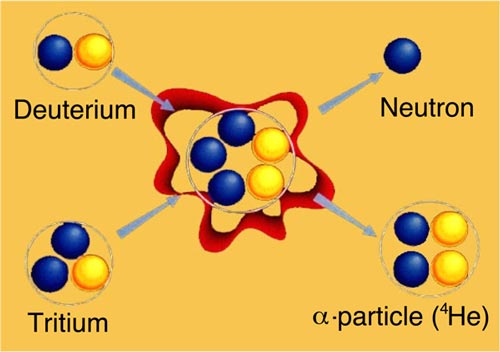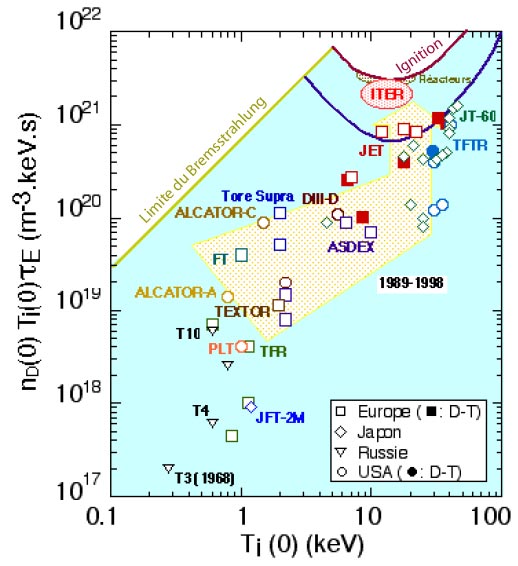The Sun gets its energy from nuclear fusion
In 1938, Hans Bethe put an end to centuries of speculation when he demonstrated that the Sun’s energy is drawn from a cycle of fusion reactions involving light nuclei such as hydrogen, helium, lithium and carbon. So much energy is released in these reactions that the Sun’s centre can reach temperatures of several million degrees Centigrade. At such high temperatures, very little nuclear ‘fuel’ is required in the fusion reactions, thus our Sun’s mass will allow it to keep on shining for a few billion years.

Deuterium-tritium fusion reaction
Of all the light nuclei fusion reactions, the deuterium-tritium fusion (involving heavy isotopes of hydrogen) releases the most energy and is considered to be the most promising one to eventually conduct on Earth.
© CEA/JET
Physicists were very quickly able to conduct nuclear fusion experiments of their own; first involving smaller amounts of energy in laboratories, before moving on to more impressive scales. The first ‘non-controlled’ thermonuclear explosions on Bikini Island in 1949 raised interest in the possibility of conducting artificial ‘controlled’ fusion on Earth. Why the interest? Well, hydrogen, helium and carbon are elements that are very abundant on our planet, and thus an ability to harness nuclear fusion could open the door on a virtually inexhaustible energy supply.
What we refer to as nuclear fusion is a reaction that temporarily binds together two lighter nuclei, where by ‘lighter’ we mean that the combined number of neutrons and protons in both nuclei is far below 60. This reaction results in the fusion of the two initial nuclei into one intermediate heavier nucleus which then decay into two other light nuclei, both different from the original pair. Tremendous amounts of energy are also released at the atomic scale, in the form of kinetic energy bestowed upon the two fusion products. The figure below shows a fusion reaction between the nuclei of deuterium (an isotope
(an isotope of hydrogen with one neutron) and tritium (an isotope of hydrogen containing two neutrons), considered to be the most promising reactions when considering the amount of energy produced.
of hydrogen with one neutron) and tritium (an isotope of hydrogen containing two neutrons), considered to be the most promising reactions when considering the amount of energy produced.
For more than fifty years, intensive research has been carried out on the question of controlled fusion. Numerous international experiments (JET in England, JT60 in Japan and TORE SUPRA in France, among others) have approached the ideal theoretical temperature, density, and reaction time required for nuclear fusion, and have observed highly encouraging results. Such experiments, however, bring with them immense technical requirements; such as the effective extraction of energy or the maintaining of temperatures in the millions of degrees C (most substances on Earth can only exist up to 3,000 degrees). These problems have not yet been resolved, but highly advanced technical solutions are being developed in an attempt to overcome them.

Fusion machine performance levels
Comparing the results of the various fusion experiments (both present and future) according to the Lawson ignition criterion.
© Euratom-JET
Of all these proposed solutions, a technique devised by Russian physicists in the 1960’s is currently the most popular. The tokamak is a magnetic ring which surrounds the (plasma) particles that need to be fused together, and heats them to several millions of degrees C. The ionised particles are kept prisoners by an intense magnetic field. They are held in place by an invisible ‘circular magnetic chamber’, so that they do not come into contact with the rest of the experimental setup.